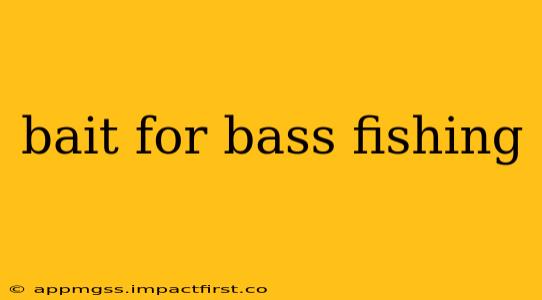Bass fishing is a popular pastime for anglers of all skill levels, but success hinges on choosing the right bait. Understanding bass behavior and selecting the appropriate lure can significantly increase your chances of landing a trophy. This guide dives deep into the world of bass fishing bait, exploring various types, techniques, and considerations to help you choose the best bait for your next fishing trip.
What are the Best Baits for Bass Fishing?
The "best" bait is highly dependent on factors like the time of year, water conditions, and the specific type of bass you're targeting (largemouth, smallmouth, spotted). However, some consistently effective options include:
-
Live Bait: This includes minnows, crawfish, and worms. Live bait is highly attractive to bass, mimicking their natural prey. The movement and scent are irresistible. However, it requires more preparation and can be less convenient than artificial lures.
-
Soft Plastics: These versatile lures include worms, grubs, lizards, and creature baits. They are incredibly effective because of their lifelike action and can be rigged in numerous ways (Texas-rigged, Carolina-rigged, etc.) to suit different conditions.
-
Hard Baits: This category encompasses crankbaits, spinnerbaits, topwater lures (poppers, buzzbaits), and jigs. These lures are durable and can cover a lot of water quickly. The choice depends on the depth, cover, and the bass's feeding behavior. Crankbaits excel in open water, while topwater lures are ideal for shallow, weedy areas.
What Kind of Bait Should I Use for Bass Fishing in Different Seasons?
Seasonal changes drastically impact bass feeding habits and preferred locations. Your bait choice should adapt accordingly:
-
Spring: As water temperatures rise, bass become more active and aggressive. Pre-spawn bass focus on energy-rich foods. Topwater lures and spinnerbaits are highly effective during this period. Soft plastics, like worms and craws, fished near spawning beds, are also a solid choice.
-
Summer: Summer bass often move to deeper water to escape the heat. Deep-diving crankbaits, jigs, and Texas-rigged worms become more productive. Focus on areas with shade and structure.
-
Fall: As the water cools, bass begin to feed heavily in preparation for winter. A variety of baits work well, including topwater lures in the mornings and evenings, and crankbaits and spinnerbaits throughout the day.
-
Winter: Bass become lethargic and less active during winter. Slow-moving baits, like Texas-rigged worms or jigs, fished slowly near structure, are often the most successful.
What is the Best Bait for Bass Fishing in Different Water Conditions?
Water clarity and temperature significantly influence bass feeding behavior.
-
Clear Water: Subtle, natural-colored lures are often preferred in clear water. Soft plastics in translucent or natural colors, and crankbaits with a natural finish, can be highly effective.
-
Murky Water: In murky water, bass rely more on vibration and scent. Larger, louder lures, such as spinnerbaits with larger blades or brightly colored soft plastics, are often the best option.
What are the Best Colors of Bait for Bass Fishing?
Bass are opportunistic feeders, but color can certainly play a role. Generally:
-
Natural Colors: Match the hatch! Colors like green pumpkin, brown, and watermelon are excellent choices, especially in clear water.
-
Bright Colors: Bright colors like chartreuse, red, and white can be effective in murky water or during low-light conditions. They create more visibility.
What are Some Tips for Choosing Bass Fishing Bait?
-
Consider the location: Structure, cover, and depth greatly impact bait selection.
-
Observe the water conditions: Clarity, temperature, and current influence bass behavior and lure choice.
-
Experiment with different baits: What works best is often a matter of trial and error. Keep a variety of baits in your tackle box.
-
Pay attention to the action of your bait: The way your lure moves in the water is just as important as its color and size.
-
Use the right size bait: Match the bait size to the size of the bass you're targeting.
By understanding these factors and experimenting with different baits, you can significantly increase your success rate in bass fishing. Remember, the thrill of the catch is often as much about the journey as it is the destination!
